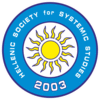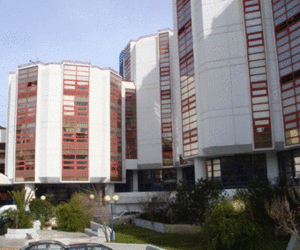WS2: System Dynamics for Business Intelligence
Workshop: System Dynamics for Business Intelligence
Chair: Mr Aris-Rallis Antoniadis
 |
| Rallis Antoniadis Rallis Antoniadis holds a B.Sc. Degree in Mathematics - University of Athens, Greece, a M.Sc. Degree in Information and Systems Science and a M.Sc. Degree in Applied Mathematics both from Carleton University, Ottawa, Canada. He is Certified Systemic e-Business Analyst Professional (CSEBAP). Rallis is a PhD Candidate at the University of Piraeus (Department of Informatics). R. Antoniadis has 25 years of professional experience as Systems Analyst – Programmer in the banking industry, the eight of which as Dept. Manager (IT Applications). He is a Member of the Board of Directors of the Hellenic Society for Systemic Studies (HSSS) and Assistant Editor at the International Journal of Applied Systemic Studies (IJASS). His main scientific interests are: Systems Thinking, Systems Dynamics, Simulation and Modeling, Information Systems, Business Analysis, Operations Research. |
Workshop Introduction The main characteristics of a modern business environment are its increased dynamics with its rapid changes and its great complexity. For modern businesses and organizations to be able to survive and maintain their competitiveness, they must be able to absorb the complexity of the environment in which they operate, while perceiving at the same time their tendencies in order to respond to its future demands in a timely manner. For this goal to be achieved, managers are charged with addressing the increased diversity that their business / organization receives, implementing the changes required and ensuring the effectiveness of their organizational processes by adapting to the latest technological developments without diverging from the short deadlines. Business Intelligence (BI) can be considered as a set of tools, processes, practices and individuals that are used to implement useful information aiming at making the right decisions in a business / organization in order to improve its competitiveness, profitability, or productivity. It is characterized by a continuous monitoring of business trends, the evolution and the rapid adaptability to constantly changing situations, making smart business decisions despite any uncertain crises or contradictory information. Based on research and analysis of irrelevant information, it is capable to provide relevant knowledge, identify trends and discover new opportunities. Systems Thinking is a relatively new way of thinking and problem solving, by treating organizations as global entities / systems while maintaining their identity and integrity and describing the dynamic relationships that influence systems’ behaviors and influences the right decision making. Systems Thinking has contributed with new effective methods of dealing with problems in a systemic rather than reductive way by looking at different behavioral archetypes and examining the underlying systemic interactions that are responsible for such behaviors and events. After all, there are plenty of examples of businesses / organizations that failed to function effectively as a whole and maintain their viability when all their individual independent sections were optimized separately without taking into account the potential impact of their own optimization on the other sections of the business / organization. System Dynamics is a methodology which, when supported with the proprietary software, enables the analysis, framing, understanding, and the ultimate problem solving that occur in complex real-world systems. Through problem modeling, decision makers are able to test their scenarios and strategies by performing experiments through effective simulation of dynamic systems to better understand problems and make rational decisions and strategy recommendations before applying them to the real-world problem. Sustainable business modeling is the process of developing a sustainable business model. Sustainable Business Modelling – Simulation Modeling of Business Model Canvas Modern companies, even if they are leaders in their business, cannot afford to stand still. In order to follow the developments of a rapidly changing environment in which they operate, they are required to interact with the socio-cultural environment in which they are located and to recognize that they are responsible for any economic, social or environmental consequences that their business activity may cause, considering at the same time all the risks managed.As a result, they are under a constant pressure to operate in a sustainable way and adopt a systemic approach, which seeks to take into account the three dimensions of sustainability - social, environmental and economic - in a way that creates shared value for all stakeholders, including the environment and society. That is, they have to adopt sustainable business thinking.Therefore, aiming at their survival, they have to monitor their environment closely, properly assess competition and try to understand their customers. To achieve their goal, they gather as much information as possible, which will be used appropriately for decision making and strategy development with respect to society and the environment.One term for gathering and analyzing business information is "business intelligence" (BI).Business Intelligence includes those strategies used to gather information to improve the competitiveness, profitability, or productivity of an organization or company.But the transition to a sustainable world necessarily requires a major change in the way businesses are designed and operated to produce sustainable value (environmental, social and economic).This means that the dominant neoclassical model of business should be radically transformed taking into account social and environmental priorities.A key factor in leveraging companies to transform their business model is the Value Proposition, which solves problems and satisfies customer needs in traditional and interested parties in viable business models.Sustainable business modelling is the process of developing a sustainable business model. However, although sustainable business model innovation is an emerging and burning issue, only a few tools are currently available to assist companies in sustainable business modelling.In this paper, Business Intelligence, Systems Thinking, System Dynamics and Sustainability are first discussed followed by the process which guarantees sustainable business modelling. Next, tools and methodologies are presented that: support sustainable business modelling, capture the value proposition taking into account all parties involved, monitor the progress of a business on the path to sustainability and examine archetypes of elements of a sustainable business model. Emphasis is given to the Business Model Canvas (BMC), a useful tool which depicts a business model. The Triple Layer Business Model Canvas is being considered which besides economics takes into account the environmental and the social dimension of the model.Through problem modelling, decision makers can test their scenarios and strategies by executing experiments by effectively simulating dynamic systems to better understand the problems and make rational decisions and strategic recommendations before applying them to the real problem.Applying System Dynamics methods, modelling and simulation of Business Model Canvas follows with the help of AnyLogic software.
| ||
 | Panagiotis Kalofonos Graduated with B.S c. in Economic as economist, achieved Master in Business Administration (MBA), is an Adult Educator and, Certified Systemic Analyst Professional CSAP candidate. Worked for over 30 years in multinational companies in USA, UK, Denmark and Greece as Marketing Manager, Export Sales manager and Entrepreneur. During the last decade he is chief consumer finance advisor in the Union of Working Consumers of Greece, and actively involved in the development of social economy in Greece.
| |
Value Proposition Canvas as a tool for systemic approaches in a rapidly accelerated world Around the world new business models are deviced, developed and implemented faster than any past decade. Long established ways of doing things, change as organisations discover or uncover new sources of value by riding the crest of rapidly decreasing technology costs, new and robust networks, the appearance of new and promishing markets and innovative ways of thinking and practicesIt is popular belief that the possibilities of business model innovation today are infinite while greater and riskier experimentations becomes more common and new business models emerge and shine better than ever.Organizations are using new business model design to build unique approaches to delivering value that have the eventual possibility to radically disrupt industries.This presentation unfolds what is considered as a prerequisite of an eventual business model innovation in the presence of numerous change drivers that are shaping the global economy and demand new approaches from organizations if they need to rethink and reshape their business models. Additionally it considers the severity of understanding the impact of systems when assessing how value is created.Creating a value proposition is an essential part of business strategy addressed as a promise of value to be developed, delivered, communicated, and acknowledged to a specific customer. On the other side from the customer viewpoint is about how his benefit will be delivered served and experienced. The development of this specific value proposition is based on a review and analysis of the benefits, costs, and value that an organization can deliver to its customers and may be perceived as a positioning of value, since Value are the benefits minus any cost and risk.Since value proposition characterizes the relationship between the successful fulfilment of client needs from products or services performance attributes and the total cost, the famous authors of BMC Osterwalder and Pigneur, suggest that the value proposition must be observed and studied through the entire value life cycle in all five stages.Starting the analysis with the VPC, provides valuable insights enabling the fulfillment of the first two segments of an intended Business Model Canvas. The Value Proposition and Customer Segments.Finally, the usage of systemic approach enhances the effectiveness of the Business Model Canvas since it takes in consideration all other factors in an augmented and holistic way besides the supplier and client side.
| ||
 | Pelagia Chourdaki Mrs. Pelagia Chourdaki holds a BA Degree in Archaeology & History of Art, a BA Degree in History, a MA in Communication and she is a PhD Candidate in the field of Systemic Approaches in Culture and Management at the University of Piraeus (Department of Informatics). She is also a Certified CulturalHeritage and Heritage Manager (UNIMED-HERIT) and has attended the Systemic Analyst in Project Management Professional (CSAP).Experienced Cultural Heritage Manager with a demonstrated history of working in public and private sector for over 20 years.Skilled in Project Management, Digital Exhibitions, Cultural Informatics, Archival Research andDocumentation, Publications, Branding and Communication. | |
System Dynamics in Tourism: Designing a Tourist Guide Application on demand Systemics with powerful tools and specialized software can face the raised complex problems in business Intelligence of the tourism sector. The latest trend is the development of tourism guide apps supported by the new digital technologies and customer-oriented content on demand. These innovative apps have the potential to personalize the tourist experience with customized services. In order to simulate the users’ behavior, a systems dynamics model has been developed using Anylogic S/W and various scenarios are explained.
| ||
 | Antonios Dragonas Antonios Dragonas was born in Athens, Greece (1961. He holds BSc in Mathematics (National and Kapodistrian University of Athens).He was a PhD candidate in Theoretical Physics (Aristotle University of Thessaloniki) and also studied Advanced Information Technologies.He is working as Computers’ and Networks’ Engineer and since 1981 he is occupying continuously with Scientific Algorithms Development and Implementation. He is also a Microsoft Certified System Engineer (MCSE since 1998), Microsoft Certified Trainer (MCT since 1998) and Cisco Certified Network Associate (CCNA since 2001).He has been teaching continuously since 1992 IT advanced courses (Computer’s and Network Technologies and Advanced Analysis and Programming).He is graduate of the CSAP Mastering Program (University of Piraeus) and the MSc Program “Advanced Technologies for Human to Computer Interaction- Artificial Intelligence” (University of Piraeus). | |
System Dynamics for fuel consumption of a commercial ship under changing cruise conditions In this paper, a model is developed, which estimates the fuel consumption of a commercial ship under changing cruise conditions for a time period selected by the model operator.The approaches to studying complex systems are based both on causally explained behaviors/states of subsystems (usually highly simplified/attenuated) of the studied system but also on compulsory "holistic approaches" of the behaviors/states of the subsystems of the studied system. These "holistic approaches"/interpretations are not causal step-by-step reconstructions from previous parts, but the methodologically robust documented examination and interpretation to produce not physical but "behavioral" rules for the studied system. We approached the extremely complex problem of "ship cruise" starting from recorded observations, which we incorporated with appropriate functional dependencies and techniques into a system dynamics model developed with Vensim PLE, as we evolved it to support the systemic time!In this model the selected parameters affecting fuel consumption are (a) Type of vessel, (b) Ship’s Speed, (c) Wind’s speed and (d) Ship’s aerodynamic resistance coefficient.Fuel’s consumption affection due to waves and resistance to air depends on the ship's cruise angle and on the air direction and we use a set of weight factors to apply the influence of the waves' speed on the cruise's energy requirements.Model’s Equivalent energy charges which due to ripple:Our approach to estimate the needs for additional energy to overcome the ripple under windy and, therefore, wavy conditions, is that the ship follows a sinusoidal cruise line, instead of the straight line from point A to point B in case that no wind exists. The length of each equivalent sinusoidal cruise is calculated using methodologies equivalent to generating systemic time from the Vensim PLE, and then contributes to the calculation of the energy charge for the cruise with the selected ripple.Longer distance coverage in the same time period results to increase the average (and instantaneous) speed of the ship, thereby increasing the energy consumed depending on the square of speed.There are screenshots available of the simulation run for various initial conditions for all parameters selected and associated with the model.
| ||



